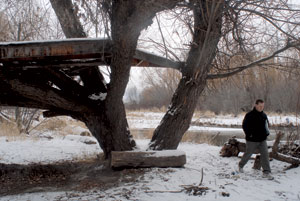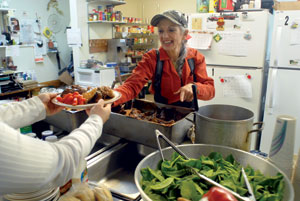Here in the Flathead, Chris Krager asks you to study the face of homelessness. He invites you to look around at his Samaritan House, the only homeless shelter in five counties.
Sure, you’ll see chronic transients, those perpetual panhandlers who shape the stereotype of homelessness. But look closer. You’ll also see the exhausted blue collar laborer; the single mother working to support her two kids but coming up short on rent payments; the former nurse practitioner who now collects disability and reminisces about her graduate school days at UCLA.
You’ll see Northwest Montana’s unique homeless problem.
“The face of homelessness around here is your waitress, your grocery store clerk – local folks down on their luck,” said Krager, director of the Samaritan House. “They come in with all kinds of stories and backgrounds and precipitating factors.”
In many ways, the Samaritan House is like other homeless shelters across the nation. It struggles to break even. It regularly turns people away because it’s already full. For many, it’s the only option other than the street. But a couple of things set it apart from the norm. For example, 60 percent of the homeless at the Samaritan House are families, compared to 22 percent nationwide, Krager said. Also, the majority are employed or transitioning between jobs.
Krager, who has been the shelter’s director for eight years, said the formula for such a high rate of employed homeless people in Flathead County is simple: high rent and low wages. He said in years past, ranchers would stop by the shelter and ask for a few capable men to put to work.
“Anymore I can’t do that,” Krager said. “They’re already working.”
The shelter is almost always full. In fact, it recently had vacancies for the first time in five years. But those few empty beds quickly filled up again. In 2007 alone, the shelter turned away 545 people. Along with the 40 or so available beds in the shelter, which are free, the Samaritan House also offers 45 apartments, ranging in price from $180 to $205 a month. The idea behind these transitional apartments is to help people get back on their feet until they find their own place, but there are no time limits. On the other hand, the shelter has a 30-day maximum, but extensions are often granted.
The Samaritan House operates on the revenue it generates from its apartments, donations, federal grants and other sources. Not a penny comes from the state. Montana, Krager said, is one of two states that don’t provide any funding for homeless shelters.
“It’s a struggle every year,” Krager said. “We try to break even and the lights are still on.”
 |
|
Carrying a blanket as a gift, Chris Krager, executive director of Samaritan House, walks past a makeshift homeless camp near Wal-Mart. |
Kathleen Curtis, 51, has been at the shelter since October. An injury several years ago forced her to quit her job as a nurse practitioner in California. She has collected disability ever since. Earlier this year she moved to Kalispell to be near her mother when West Coast life became too expensive. She quietly mentions her master’s degree.
“I was brought to my knees,” Curtis said. “But I’m grateful for the food and a place to lay down at night.”
Though Curtis says she enjoys visiting her mother at an assisted living facility, even that is a stark reminder of her own situation.
“It sounds kind of like an oxymoron: She’s at this really nice assisted living and I’m here,” said Curtis, sitting in the shelter’s dining room.
Diversity thrives in the Samaritan House. There’s 27-year-old Coty Low who recently got out of jail to find himself evicted from his trailer. There’s 24-year-old Ashley Griffin who couldn’t find a job in the one-store town of Trego where she lived with her father. She’s job searching. So is Low. So are many others at the shelter. Some are women running from domestic violence and others are just getting out of the cold for a few days before moving back into their car. Then there are the shelter residents who work but can’t pay rent. They are all ages.
 |
|
Marie Silverman serves Crystal Keil a large plate of food during dinner at the Samaritan House Homeless Shelter and Transitional Housing. Keil, who recently moved into the women’s dorm and has a job locally, said if it weren’t for the shelter she would be living in her car. |
In the culture of homeless care, there are two categories: chronically and episodically homeless. Chronically is defined as people who have been homeless for at least 12 months or homeless four times in the last 12 months. Also, they must have a disability. Episodically homeless are the ones down on their luck. Job seekers. Single mothers. Most of the people at the Samaritan House.
In the subculture of homelessness, there are also two categories: bums and hobos, or tramps and vagabonds, respectively. Bums beg and panhandle; hobos find day labor and keep on the move. They don’t get along, Krager said, but they often share the same turf – like homeless camps.
At a homeless camp tucked away in the woods along the Stillwater River in Kalispell, a platform that resembles a tree house sits 10 feet up in a large cottonwood tree, providing both an elevated bedding surface and a covered sleeping area for those below. There are makeshift benches made from logs and a fire pit full of twigs. While evidence like Busch beer cans dotted with B.B. gun holes and meandering footprints in the snow suggest current occupation, the camp is quieter now than in the warmer summer months, Krager said. Kalispell has other similar camps.
“A blue tarp and a $9 tent and you’re good to go,” Krager said.
Homeless people stay on the streets and resort to camps for a few reasons, Krager said. One reason is because the shelter is full. Another is that they’re not ready to commit to a new lifestyle. Some just can’t quit drinking, and there’s no alcohol allowed in the Samaritan House. And lastly, Krager has a theory on why some remain perpetually homeless: They’re living a dream. Blame it on Jack Kerouac, the famous roving author of the Beat Generation.
“The main reason that chronically homeless stay that way is the mystical romanticism that ‘The Man’ has nothing on me,” Krager said. “Ultimately it’s a big lie.”
The goal at the Samaritan House is “normalization.” Residents develop routines: breakfast at 7 a.m.; hopefully work shortly afterward with a sack lunch in hand; dinner at 6 p.m.; locked doors by 10. Fit in some laundry time, maybe a movie and call it a day. Everybody does chores and few complain. It’s a community and it’s a home, but ultimately it’s not their home. People like Curtis understand that all too clearly.
“My goal isn’t to stay forever,” she said. “My goal is to have my own place and have my daughter come and visit. My own place.”